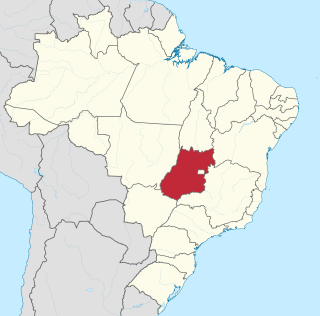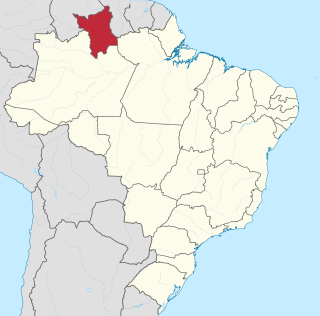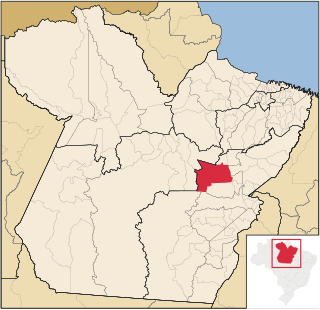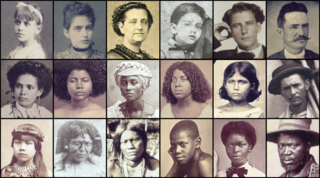Delays
Originally, the census, being carried out decennially, was supposed to take place in mid-2020. However, due to the current COVID-19 pandemic, the Brazilian Institute of Geography and Statistics changed the date to 2021. [1]
However, in early 2021, the budget of census was cut from around 2 billion reais to only 240 million, only 12% of the original value. [2] The census was pushed again, with Brazil's Supreme Court ruling that the government had to perform the census in 2022. [3]
While the original reference date was June 1, 2022, the IBGE changed the date to August 1, 2022, due to the change in the company that would hire the workers. [4]

Goiás is a Brazilian state located in the Center-West region. Goiás borders the Federal District and the states of Tocantins, Bahia, Minas Gerais, Mato Grosso do Sul and Mato Grosso. The state capital is Goiânia. With 7.2 million inhabitants, Goiás is the most populous state in the Center-West and the 11th most populous in the country. It has the ninth largest economy among Brazilian federative units. In Brazil's geoeconomic division, Goiás belongs to the Centro-Sul (Center-South), being the northernmost state of the southern portion of Brazil. The state has 3.3% of the Brazilian population and is responsible for 2.7% of the Brazilian GDP.

Minas Gerais is one of the 27 federative units of Brazil, being the fourth largest state by area and the second largest in number of inhabitants with a population of 20,539,989 according to the 2022 census. Located in the Southeast Region of the country, it is limited to south and southwest with São Paulo; Mato Grosso do Sul to the west; Goiás and the Federal District to the northwest; Bahia to the north and northeast; Espírito Santo to the east; and Rio de Janeiro to the southeast. The state's capital and largest city, Belo Horizonte, is a major urban and finance center in Brazil, being the sixth most populous municipality in the country while its metropolitan area ranks as the third largest in Brazil with just over 5.8 million inhabitants, after those of São Paulo and Rio de Janeiro. Minas Gerais' territory is subdivided into 853 municipalities, the largest number among Brazilian states.

Maranhão is a state in Brazil. Located in the country's Northeast Region, it has a population of about 7 million and an area of 332,000 km2 (128,000 sq mi). Clockwise from north, it borders on the Atlantic Ocean for 2,243 km and the states of Piauí, Tocantins and Pará. The people of Maranhão have a distinctive accent within the common Northeastern Brazilian dialect. Maranhão is described in literary works such as Exile Song by Gonçalves Dias and Casa de Pensão by Aluísio Azevedo.

Rio de Janeiro is one of the 27 federative units of Brazil. It has the second largest economy of Brazil, with the largest being that of the state of São Paulo. The state, which has 8.2% of the Brazilian population, is responsible for 9.2% of the Brazilian GDP.

Roraima is one of the 26 states of Brazil. Located in the country's North Region, it is the northernmost and most geographically and logistically isolated state in Brazil. It is bordered by the state of Pará to the southeast, Amazonas to the south and west, Venezuela to the north and northwest, and Guyana to the east.

In Brazil, Pardo is an ethnic and skin color category used by the Brazilian Institute of Geography and Statistics (IBGE) in the Brazilian censuses. The term "pardo" is a complex one, more commonly used to refer to Brazilians of mixed ethnic ancestries.
The Brazilian Institute of Geography and Statistics is the agency responsible for official collection of statistical, geographic, cartographic, geodetic and environmental information in Brazil. IBGE performs a decennial national census; questionnaires account for information such as age, household income, literacy, education, occupation and hygiene levels.

Brazil is a predominantly Christian country with Islam being a minority religion, first brought by African slaves and then by Lebanese and Syrian immigrants. Due to the secular nature of Brazil's constitution, Muslims are free to proselytize and build places of worship in the country. However, Islam isn't independently included in charts and graphics representing religions in Brazil due to its very small size, being grouped in "other religions", which generally represent about 1% of the country's population. The number of Muslims in Brazil, according to the 2010 census, was 35,207 out of a population of approximately 191 million people. This corresponds to 0.018% of the Brazilian population.

This is a list of the 50 largest cities in the Americas by population residing within city limits as of 2015, the most recent year for which official population census results, estimates, or short-term projections are available for most of these cities. These figures do not reflect the population of the urban agglomeration or metropolitan area which typically do not coincide with the administrative boundaries of the city. For a list of the latter, see List of metropolitan areas in the Americas by population. These figures refer to mid-2015 populations with the following exceptions:
- Mexican cities, whose figures derive from the 2015 Intercensal Survey conducted by INEGI with a reference date of 15 March 2015;
- Calgary, whose 2015 municipal census had a reference date of April 1.
- Brazilian cities, whose figures originate from the 2021 estimate given by the IBGE, with a reference date of July 1, 2021.

Abreu e Lima is a Brazilian municipality in the state of Pernambuco. It is located in the Metropolitan Region of Recife, also known as Greater Recife. Abreu e Lima covers 126.193 km2 (48.723 sq mi), and has a population of 100,346 with a population density of 780 inhabitants per square kilometer. 75% of the area of the municipality is rural, but only 8% of the population lives outside of the urban center.

Brazil had an official resident population of 203 million in 2022, according to IBGE. Brazil is the seventh most populous country in the world, and the second most populous in the Americas and Western Hemisphere.

Vargeão is a municipality located in the state of Santa Catarina in the south region of Brazil. It is located in the Immediate Geographic Region of Xanxerê and the Intermediate Geographic Region of Chapecó and at 298 miles away from the capital of Santa Catarina, Florianópolis.

Faxinal dos Guedes is a municipality located in the west of the state of Santa Catarina, in the South Region of Brazil. Its population, according to the 2022 Brazilian Institute of Geography and Statistics Census, was 11 192 inhabitants. With an area of 340,070 km2, part of its territory is located on the western edge of a meteoritic crater, the Vargeão Dome.

Novo Repartimento is a municipality in the state of Pará, Brazil. It belongs to the mesoregion of Southeastern Pará and to the microregion of Tucuruí. In 2022, its population was 60,438 inhabitants.
Campo Redondo is a municipality in the state of Rio Grande do Norte in the Northeast region of Brazil. According to the census conducted by the IBGE in the year 2010, its population is 10 427 inhabitants. In 2022, the same body carried out the demographic census of 2022 and released the previous results of the Census. According to IBGE, Campo Redondo had a population deficit, with 210 fewer inhabitants compared to the 2010 Census. The territorial extension of the municipality is 213 km².

Muriqui is a district of the municipality of Mangaratiba, located within the Greater Rio de Janeiro, Brazil. It is part of the Green Coast. Highway BR-101 passes through the district.

Abraham Bragança de Vasconcellos Weintraub is a Brazilian economist and investment banker who served as Brazil's Minister of Education from 2019 to 2020. He served as the Executive Director for the World Bank from the 15th district from 2020 to 2022, when he resigned his post in order to run in the 2022 São Paulo gubernatorial election.

The COVID-19 pandemic in Brazil has resulted in 37,519,960 confirmed cases of COVID-19 and 702,116 deaths. The virus was confirmed to have spread to Brazil on 25 February 2020, when a man from São Paulo who had traveled to Italy tested positive for the virus. The disease had spread to every federative unit of Brazil by 21 March. On 19 June 2020, the country reported its one millionth case and nearly 49,000 reported deaths. One estimate of under-reporting was 22.62% of total reported COVID-19 mortality in 2020.
The Brazilian 2010 Census was the twelfth and, as of March 2022, the most recent census of Brazil, organized by the Brazilian Institute of Geography and Statistics (IBGE), with the reference date being August 1, 2010. The population was found to be a record 190,755,799, an increase of 12.5%. The population aged, with the median age now being 29, compared to 25 in 2000. The next census is to take place on August 1, 2022, after two cancelations, one to the COVID-19 pandemic, and the other due to budgetary restraints.

The 1872 Brazilian census was the first census carried out in Brazilian territory, during the imperial period. All residents in private and collective households who were in it on the reference date of the census, which was 1 August 1872, were censused. The population was distributed according to color, sex, free or slave status, marital status, nationality, occupation and religion.

















